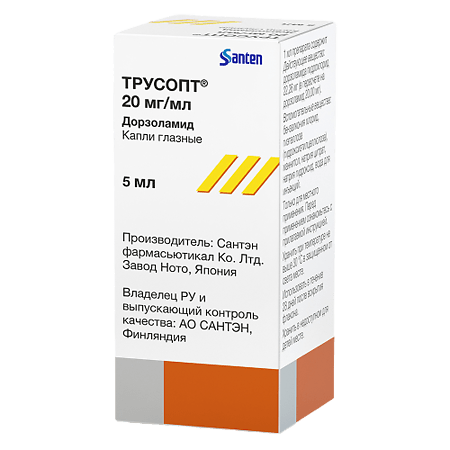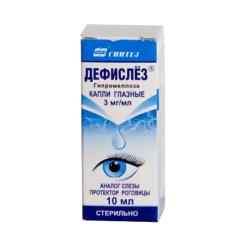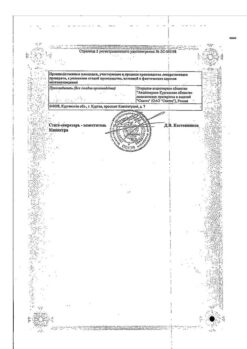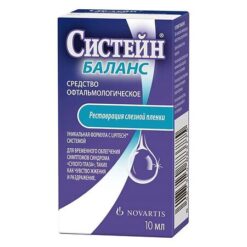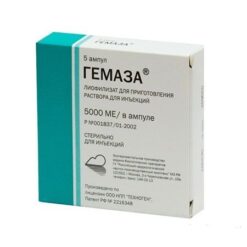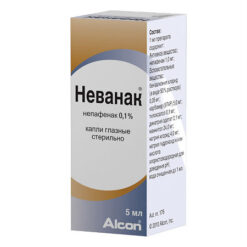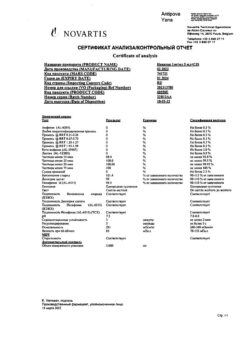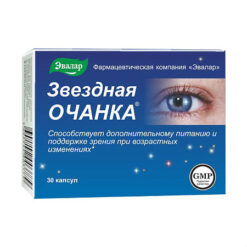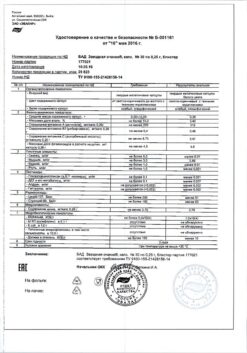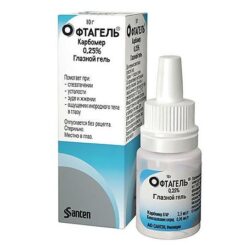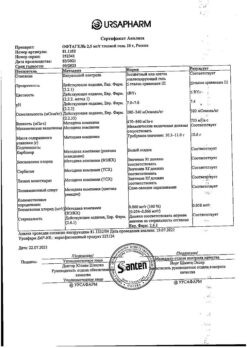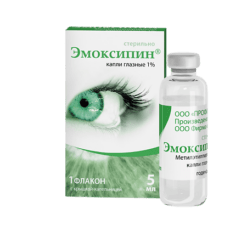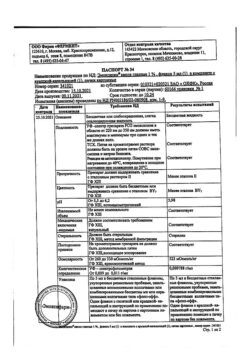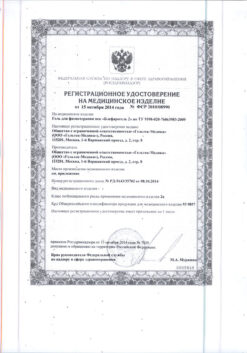No products in the cart.
Trusopt, eye drops 20 mg/ml 5 ml
€9.28 €8.12
Description
Pharmacotherapeutic group
A carboangidrase inhibitor antiglaucoma drug.
Code ATX: S01EC03
Pharmacological properties Pharmacodynamics
Mechanism of action
Carboanhydrase (CA) is an enzyme found in many body tissues, including the eye. In humans, carboanhydrase is represented by a number of isoenzymes, the most active of which is carboanhydrase II (CA-II), found mainly in erythrocytes but also in other tissues. Inhibition of carboanhydrase in the ciliary processes of the eye leads to a decrease in aqueous humor secretion, resulting in lower intraocular pressure (IOP).
Trusopt® contains dorzolamide hydrochloride, which is a strong selective inhibitor of human carboanhydrase II. Following topical ophthalmic application of dorzolamide, elevated IOP decreases whether or not it is related to glaucoma. Elevated IOP is a major risk factor in the pathogenesis of optic nerve damage and visual field narrowing. Dorzolamide reduces IOP without the common side effects of myotics such as nictalopia, accommodation spasm, and pupil constriction. Dorzolamide has little or no effect on heart rate or blood pressure. Beta-adrenoblockers for topical ophthalmic use also lower IOP by reducing aqueous humor production, but their mechanism of action is different. Studies have shown that when dorzolamide is added to beta-adrenoblockers for topical use in ophthalmology, there is an additional decrease in IOP. This confirms the previously obtained data on the additive effect when using beta-adrenoblockers and oral carboenhydrase inhibitors together.
Clinical efficacy and safety Adult patients
Efficacy of dorzolamide in patients with glaucoma or intraocular hypertension when administered 3 times daily as monotherapy (baseline IOP ≥23 mmHg Std.) or 2 times daily as adjunctive therapy to ophthalmic beta-adrenoblockers (baseline IOP ≥22 mm Hg) has been demonstrated in large-scale clinical trials lasting up to one year. The effect of IOP reduction with dorzolamide as monotherapy and as adjunctive therapy has been demonstrated throughout the day, and this effect has been maintained with prolonged use. Efficacy with prolonged monotherapy was similar to betaxolol and slightly less than with timolol. When used as adjunctive therapy to ophthalmic beta-blockers, dorzolamide demonstrated an additional reduction in IOP similar to that seen with pilocarpine 2% once daily. Children
A 3-month, double-blind, multicenter study to evaluate the safety of Trusopt® when administered topically three times daily, using the active drug as a control, was conducted in 184 children aged 1 week to 6 years with glaucoma or elevated IOP (IOP at baseline > 22 mmHg Hg) (122 of whom received dorzolamide). Congenital glaucoma was diagnosed in about half of the patients in both groups; other common causes of elevated IOP were Sturge-Weber syndrome, iridocorneal mesenchymal dysplasia, and aphakia. The distribution by age and treatment used in the monotherapy phase was as follows:
Dorzolamide 2% | Timolol | |||
Age group: Under 2 years | N=56 Age range: 1-23 months | Timolol GS 0.25% N=27 Age range: 0.25-22 months | ||
Age range: 2 to 6 years | N=66 Age range: 2 to 6 years | Timolol 0.50 % N = 35 Age range: 2 to 6 years |
In both age groups, about 70 patients were treated for at least 61 days, and about 50 patients were treated for 81-100 days.
If IOP was not sufficiently controlled with dorzolamide or
timolol-gel monotherapy, open therapy was modified as follows: 30 patients younger than 2 years were switched to concomitant therapy with 0.25% timolol-gel once daily and dorzolamide 2% three times daily; 30 patients younger than 2 years were switched to a fixed combination of 2% dorzolamide and 0.5% timolol twice daily.
In general, this study found no additional safety risks to the drug in pediatric patients: approximately 26% (20% received dorzolamide monotherapy) of children experienced drug-related side effects, most of which were local non-serious eye effects such as burning and tingling sensations in the eyes, hyperemia, and eye pain. A small percentage of patients (< 4%) experienced corneal edema or clouding. Local reactions were recorded with a frequency similar to that of the comparison drug. In the post-registration period, metabolic acidosis was observed in young patients, especially in children with immature kidneys or impaired renal function.
The results of the efficacy evaluation in children indicate that the mean IOP reduction observed in the dorzolamide group was comparable to the mean IOP reduction observed in the timolol group, even with a small quantitative advantage observed with timolol. Data from long-term efficacy studies (> 12 weeks) are not available.
Pharmacokinetics
In contrast to oral carboanhydrase inhibitors, dorzolamide acts directly in the eye at significantly lower doses, resulting in less systemic exposure. In clinical studies, dorzolamide reduced IOP without the acid-base balance or electrolyte changes that are common with oral carboane hydrase inhibitors.
Dorzolamide enters the systemic bloodstream when used topically. To assess the potential for systemic inhibition of carboanhydrase after topical administration, concentrations of dorzolamide and its metabolite in erythrocytes (RBC) and plasma as well as carboanhydrase inhibition in erythrocytes were measured. With long-term use, dorzolamide accumulates in erythrocytes as a result of selective binding to carboanhydrase-II (CA-II), while extremely low concentrations of free dorzolamide are maintained in plasma. Dorzolamide forms the metabolite N-dezethyl, which inhibits CA-II to a lesser extent than the original active ingredient, but also inhibits the less active CA-I isoenzyme. The metabolite also accumulates in erythrocytes, where it binds predominantly to CA-I. Dorzolamide binds moderately to plasma proteins (approximately 33%) and is excreted mainly unchanged in the urine; the metabolite is also excreted in the urine. Nonlinear washout of dorzolamide occurs after discontinuation of the drug, initially leading to a rapid decrease in dorzolamide concentrations, followed by a slow elimination phase with a half-life of approximately four months.
When dorzolamide was given orally to simulate maximum systemic effects after long-term topical administration, the steady state was reached within 13 weeks. At steady state, there was virtually no free dorzolamide or its metabolite in plasma; CA inhibition in erythrocytes was less significant than expected for the required pharmacological effects on renal function or respiration. Similar pharmacokinetic results were observed after prolonged topical administration of dorzolamide hydrochloride. However, some elderly patients with renal insufficiency (established creatinine clearance
30-60 ml/min) had higher concentrations of metabolites in erythrocytes, but no significant differences in carboenhydrase inhibition and no clinically significant systemic side effects were directly associated.
In some elderly patients with renal insufficiency (established creatinine clearance
30-60 ml/min), higher concentrations of metabolites were noted in the red blood cells.
Indications
Indications
The drug Trusopt® is indicated for adults for the treatment of elevated IOP with:
ocular hypertension
primary open angle glaucoma
pseudoexfoliative glaucoma
secondary glaucoma (without blocking the angle of the anterior chamber of the eye) And also:
as an additional therapy to beta blockers
as monotherapy in patients who do not respond to beta blockers or for whom beta blockers are contraindicated
Trusopt® is indicated for children
for the treatment of glaucoma in children from 1 week of age as monotherapy or in addition to treatment with beta-blockers
Pharmacological effect
Pharmacological effect
Pharmacotherapeutic group
Antiglaucoma agent – carbonic anhydrase inhibitor.
ATC code: S01EC03
Pharmacological properties Pharmacodynamics
Mechanism of action
Carbonic anhydrase (CA) is an enzyme found in many tissues of the body, including the eye. In humans, carbonic anhydrase is represented by a number of isoenzymes, the most active of which is carbonic anhydrase II (CA-II), found mainly in erythrocytes, as well as in other tissues. Inhibition of carbonic anhydrase in the ciliary processes of the eye leads to a decrease in the secretion of aqueous humor, resulting in a decrease in intraocular pressure (IOP).
The drug Trusopt® contains dorzolamide hydrochloride, which is a strong selective inhibitor of human carbonic anhydrase II. After topical ophthalmic application of dorzolamide, elevated IOP is reduced regardless of whether it is associated with glaucoma or not. Increased IOP is a major risk factor in the pathogenesis of optic nerve damage and narrowing of visual fields. Dorzolamide reduces IOP without the side effects common to miotic drugs, such as nyctalopia, accommodation spasm, and pupillary constriction. Dorzolamide has minimal or no effect on heart rate or blood pressure.
Beta-blockers for topical use in ophthalmology also reduce IOP by reducing the production of aqueous humor, but their mechanism of action is different. Studies have shown that when dorzolamide is added to beta-blockers for topical use in ophthalmology, an additional reduction in IOP is observed. This confirms previously obtained data on the additive effect of the combined use of beta-blockers and oral carbonic anhydrase inhibitors.
Clinical efficacy and safety Adult patients
The effectiveness of dorzolamide in patients with glaucoma or ocular hypertension when used 3 times daily as monotherapy (initial IOP ≥ 23 mm Hg) or twice daily as add-on therapy to ophthalmic beta-blockers (initial IOP ≥ 22 mm Hg) has been demonstrated in large-scale clinical trials. studies lasting up to one year. The IOP-lowering effect of dorzolamide as monotherapy and as adjunctive therapy was demonstrated throughout the day, and this effect was maintained with long-term use. Efficacy with long-term monotherapy was similar to betaxolol and slightly less than timolol. When used as adjunctive therapy to ophthalmic beta-blockers, dorzolamide demonstrated additional IOP reduction similar to that of pilocarpine 2% once daily. Children
A 3-month, double-blind, multicenter study to evaluate the safety of Trusopt® when administered topically three times daily, using active drug as control, was conducted in 184 children aged 1 week to 6 years with glaucoma or elevated IOP (baseline IOP > 22 mmHg) (122 of whom received dorzolamide). Approximately half of the patients in both groups were diagnosed with congenital glaucoma; other common causes of elevated IOP were Sturge-Weber syndrome, iridocorneal mesenchymal dysplasia, and aphakia. The distribution by age and treatment used at the monotherapy stage was as follows:
Dorzolamide 2%
Timolol
Age group: under 2 years old
N=56
Age range: 1-23 months
Timolol GS 0.25% N=27
Age range: 0.25-22 months
Age group: from 2 to 6 years
N=66
Age range: from 2 to 6 years
Timolol 0.50% N = 35
Age range: from 2 to 6 years
In both age groups, approximately 70 patients received treatment for at least 61 days, and approximately 50 patients received treatment for 81-100 days.
If IOP was not sufficiently controlled during monotherapy with dorzolamide or
timolol gel, open therapy was modified as follows: 30 patients under 2 years of age were switched to concomitant therapy with timolol gel 0.25% once daily and dorzolamide 2% three times daily; 30 patients under 2 years of age were switched to a fixed combination of 2% dorzolamide and 0.5% timolol twice daily.
Overall, this study did not identify additional drug safety concerns in pediatric patients: approximately 26% (20% receiving dorzolamide monotherapy) of children experienced drug-related side effects, the majority of which were local non-serious ocular effects such as ocular burning and stinging, redness, and eye pain. A small percentage of patients (<4%) experienced corneal edema or clouding. Local reactions were recorded with a frequency similar to that for the comparator drug. In the post-marketing period, metabolic acidosis has been observed in young patients, especially in children with immature kidneys or impaired renal function.
Effectiveness results in children indicate that the mean IOP reduction observed in the dorzolamide group was comparable to the mean IOP reduction observed in the timolol group, even though the quantitative benefit observed with timolol was small. Data from long-term efficacy studies (>12 weeks) are not available.
Pharmacokinetics
Unlike oral carbonic anhydrase inhibitors, when applied topically, dorzolamide acts directly in the eye at significantly lower doses, resulting in less systemic exposure. In clinical studies, dorzolamide reduced IOP without the acid-base disturbances or electrolyte changes associated with oral carbonic anhydrase inhibitors.
When applied topically, dorzolamide enters the systemic circulation. To evaluate the potential for systemic carbonic anhydrase inhibition following topical administration, red blood cell (RBC) and plasma concentrations of dorzolamide and its metabolite, as well as carbonic anhydrase inhibition in erythrocytes, were measured. With long-term use, dorzolamide accumulates in red blood cells as a result of selective binding to carbonic anhydrase-II (CA-II), while extremely low concentrations of free dorzolamide remain in the plasma. Dorzolamide forms a metabolite, N-desethyl, which inhibits CA-II to a lesser extent than the parent active substance, but also inhibits the less active CA-I isoenzyme. The metabolite also accumulates in erythrocytes, where it binds predominantly to CA-I. Dorzolamide is moderately bound to plasma proteins (approximately 33%) and is excreted in the urine predominantly unchanged; the metabolite is also excreted in the urine. After discontinuation of the drug, a nonlinear washout of dorzolamide occurs, which initially leads to a rapid decrease in dorzolamide concentrations, followed by a slow elimination phase with a half-life of about four months.
When dorzolamide was administered orally to mimic the maximum systemic exposure after long-term topical administration, steady state was achieved within 13 weeks. At steady state, there was virtually no free dorzolamide or its metabolite in plasma; CA inhibition in erythrocytes was less significant than expected for the required pharmacological effects on renal function or respiration. Similar pharmacokinetic results were observed after chronic topical administration of dorzolamide hydrochloride. However, in some elderly patients with renal impairment (estimated creatinine clearance
30-60 mL/min), higher erythrocyte concentrations of metabolites were noted, but no significant differences in carbonic anhydrase inhibition and no clinically significant systemic side effects were directly associated with this.
Special instructions
Special instructions
The use of dorzolamide in patients with acute angle-closure glaucoma has not been studied. Treatment of patients with acute angle-closure glaucoma requires emergency treatment measures in addition to topical ophthalmic antihypertensive agents.
Dorzolamide contains a sulfonamide group, which is also found in sulfonamides, and although the drug is applied topically, it is also absorbed into the systemic circulation. Thus, the same types of adverse reactions that have been found with systemic administration of sulfonamides may occur with topical administration, including severe reactions such as Stevens-Johnson syndrome and toxic epidermal necrolysis. If signs of serious reactions or hypersensitivity reactions occur, stop using this drug.
Treatment with oral carbonic anhydrase inhibitors is associated with the development of urolithiasis due to acid-base imbalance, especially in patients with a history of kidney stones. Despite the fact that no disturbances in acid-base balance were observed with the use of dorzolamide, there have been rare reports of cases of urolithiasis. Because dorzolamide contains a topical ophthalmic carbonic anhydrase inhibitor that is absorbed into the systemic circulation, patients with a history of urinary tract stones may have an increased risk of developing urolithiasis when using this drug.
If allergic reactions occur (for example, conjunctivitis and eyelid reactions), you should consider stopping use of the drug.
There is a potential for additive effects to the known systemic effects of carbonic anhydrase inhibition in patients receiving an oral carbonic anhydrase inhibitor and dorzolamide.
Concomitant use of dorzolamide and oral carbonic anhydrase inhibitors is not recommended. Corneal edema and irreversible corneal decompensation have been reported with the use of dorzolamide in patients with pre-existing recurrent corneal erosions and/or who have undergone surgery involving disruption of the integrity of the eyeball. The likelihood of developing corneal edema also increases. Precautions should be taken when prescribing Trusopt® to these groups of patients.
Detachment of the choroid, accompanied by ocular hypotony, has been reported in the case of the use of solutions of ophthalmic drugs that reduce the secretion of aqueous humor after surgical interventions to restore the outflow of intraocular fluid.
Dorzolamide has not been studied in patients with severe renal impairment (creatinine clearance
<30 ml/min) or with hyperchloremic acidosis. Since dorzolamide and its metabolites are eliminated primarily by the kidneys, dorzolamide is contraindicated in such patients.
Trusopt® contains the preservative benzalkonium chloride, which can cause eye irritation. In patients with corneal disease and dry eye syndrome, when using a drug containing benzalkonium chloride as a preservative, the development of ulcerative toxic keratopathy or punctate keratopathy is possible. During long-term therapy with Trusopt® in such patients, it is necessary to monitor the condition of the cornea.
Before using the drug, contact lenses must be removed and put back on no earlier than 15 minutes after instillation. Benzalkonium chloride can discolor soft contact lenses. Use in children
Dorzolamide has not been studied in patients less than 36 weeks’ gestational age and less than 1 week of age. Patients with significant renal tubular immaturity should receive dorzolamide only after careful evaluation of the benefit versus risk associated with the potential risk of metabolic acidosis.
Influence on the ability to drive vehicles and machinery
There have been no studies of the effect of the drug on the ability to drive vehicles and operate machinery. However, possible adverse reactions, such as dizziness and blurred vision, may affect the ability to drive and/or operate machinery.
Instructions for use Okumeter Plus Bottle
Before using the drug for the first time, you must make sure that the protective strip on the outside of the bottle is not damaged. Unopened bottles may have a gap between the bottle and the cap.
First you need to wash your hands, then remove the protective strip in order to open the cap.
To open the bottle, you need to unscrew the cap by turning it in the direction of the directional arrows on the top surface of the cap. Do not pull the cap straight up and away from the bottle.
Tilt your head back and slightly pull the lower eyelid down to create a space between the eyelid and the eye.
Turn the bottle over and lightly press with your thumb or forefinger in the place specially marked on the bottle so that one drop gets into the eye, as prescribed by your doctor. DO NOT TOUCH THE SURFACE OF THE EYE OR EYELID WITH THE TIP OF THE BOTTLE.
If used incorrectly, ophthalmic medications can become infected with common bacteria that cause eye diseases. Severe eye damage and subsequent vision loss may occur due to the use of contaminated ophthalmic medications. If you suspect that the drug may be contaminated, or if you develop an eye infection, you should contact your doctor immediately about continued use of the bottle.
If it is difficult to dispense drops after first opening, place the cap on the bottle and tighten (do not overtighten) and then remove by turning the cap in opposite directions as indicated by the arrows on the top of the cap.
Repeat steps 4 – 5 for the other eye if directed by your doctor.
Close the bottle with the cap, screwing it until it comes into full contact with the bottle. When closed correctly, the arrow on the bottle cap should align with the arrow on the bottle label. Do not tighten the cap too tightly, otherwise you may damage the bottle or cap.
The dispenser tip is designed for one drop, do not enlarge the opening of the specially designed dispenser tip.
After all doses have been used, there may be residues of Trusopt® left in the vial. You do not have to worry as an additional amount of the drug has been added and you will receive the full amount of Trusopt® that your doctor prescribed. Do not attempt to remove excess medication from the bottle.
Bottle of LDPE (Low Density Polyethylene)
1. Wash your hands
2. Open the bottle. Be careful not to let the tip of the dispenser touch your eyes, the skin around your eyes, or your fingers.
3. Tilt your head back, turn the bottle over your eye.
4. Pull your lower eyelid down and look up. Holding and gently squeezing the bottle on its flattened sides, place one drop into the space between the lower eyelid and the eye.
5. Press your finger on the inner corner of your eye, pressing it towards your nose, or close your eyes for 2 minutes. This helps keep the drug from reaching other parts of the body.
6. Repeat steps 3-5 with the other eye if directed by your doctor.
7. Replace the cap and close the bottle tightly.
Active ingredient
Active ingredient
Dorzolamide
Composition
Composition
1 ml of the drug contains:
Active ingredient: dorzolamide hydrochloride – 22.26 mg (in terms of dorzolamide – 20.00 mg). Excipients: mannitol 23.00 mg, hyaetellose (hydroxyethylcellulose) 4.75 mg, sodium citrate 2.94 mg, benzalkonium chloride 0.075 mg, sodium hydroxide for pH correction 5.5-5.8, water for injection up to 1 ml.
Pregnancy
Pregnancy
Pregnancy
Dorzolamide should not be used during pregnancy. There are no or limited data on the use of dorzolamide in pregnant women. In rabbits, dorzolamide was teratogenic at doses toxic to pregnant females.
Breastfeeding
It is not known whether dorzolamide or its metabolites are excreted into breast milk. Available pharmacodynamic/toxicological data from animal studies indicate that its metabolites are excreted in breast milk. Taking into account the benefits of breastfeeding for the child and the benefits of therapy for the woman, a decision must be made as to whether to stop breastfeeding or to stop/abstain from therapy with Trusopt®. A risk to neonates/infants cannot be excluded.
Fertility
Data from animal studies do not suggest an effect of dorzolamide therapy on fertility in males or females. There are no data from human studies.
Contraindications
Contraindications
hypersensitivity to the active substance or any of the excipients
severe renal failure
hyperchloremic acidosis
pregnancy
breastfeeding period
babies under 1 week old
Side Effects
Side Effects
Trusopt® has been evaluated in more than 1,400 patients in controlled and uncontrolled clinical studies. In clinical studies, Trusopt® was prescribed to 1108 patients as monotherapy or add-on therapy to treatment with topical beta-blockers in ophthalmology. In approximately 3% of patients, the drug was discontinued due to drug-related local ocular adverse reactions, the most common being conjunctivitis and eyelid reactions.
The following adverse reactions to dorzolamide have been reported either during clinical trials or during post-marketing use.
The frequency of possible adverse reactions listed below is determined using the following convention: [(very common (≥1/10), common (≥1/100, <1/10); uncommon (≥1/1000, <1/100); rare (≥1/10000, <1/1000) and frequency unknown (frequency cannot be determined from available data)]. Nervous system disorders
Common: headache
Rare: dizziness, paresthesia. organ of vision Very common: burning and pain
Common: superficial punctate keratitis, lacrimation, conjunctivitis, inflammation of the eyelids, itchy eyes, irritation of the eyelids, blurred vision
Uncommon: iridocyclitis
Rare: eye irritation, including redness of the eyes, eye pain, eyelid hyperkeratosis, transient myopia (disappearing after discontinuation of the drug), corneal edema, hypotony of the eyes, detachment of the choroidal membrane of the eye after surgical interventions to restore the outflow of intraocular fluid Frequency unknown: sensation of a foreign body in the eye
Cardiac disorders
Frequency unknown: palpitation
Disorders of the respiratory system, chest and mediastinal organs
Rare: nosebleeds Frequency unknown: shortness of breath
Gastrointestinal tract disorders
Common: nausea, bitter taste in the mouth Rare: sore throat, dry mouth
Skin and subcutaneous tissue disorders
Rare: contact dermatitis, Stevens-Johnson syndrome and toxic epidermal necrolysis
Renal and urinary disorders pathways
Rarely: urolithiasis
General disorders and disorders at the injection site
Common: asthenia/fatigue
Rare: allergic reactions – signs and symptoms of local reactions (of the eyelids) and systemic allergic reactions, including angioedema, urticaria, itching, rash, difficulty breathing, less commonly – bronchospasm
Research
When used No clinically significant electrolyte disturbances were observed with dorzolamide.
Reporting Potential Adverse Reactions
It is important to report suspected adverse reactions after use of the drug. This allows continued monitoring of the benefit-risk ratio of the drug. Healthcare professionals should report any suspected adverse reactions through the national adverse reaction reporting system.
Interaction
Interaction
No special studies have been conducted to study the interaction of Trusopt® with other drugs.
In clinical studies, Trusopt® was prescribed simultaneously with other drugs, including timolol and betaxolol for topical use in ophthalmology, as well as drugs for systemic use: ACE inhibitors, calcium channel blockers, diuretics, non-steroidal anti-inflammatory drugs (including acetylsalicylic acid), hormones (estrogen, insulin, thyroxine). No adverse interactions were noted. There is insufficient information on the combined use of dorzolamide, miotics and adrenergic receptor agonists in antihypertensive therapy for glaucoma.
Overdose
Overdose
Only limited information is available regarding human overdose following accidental or intentional ingestion of dorzolamide hydrochloride.
Symptoms
In case of accidental ingestion, the following symptoms may occur: drowsiness, nausea, dizziness, headache, weakness, unusual dreams and dysphagia.
Treatment
Treatment should be symptomatic and supportive. Possible electrolyte imbalance, development of acidosis and side effects from the central nervous system. Serum electrolyte levels (particularly potassium) and blood pH levels should be monitored.
Storage conditions
Storage conditions
Store at a temperature not exceeding 30°C in a place protected from light. Keep out of the reach of children.
Shelf life
Shelf life
2 years.
Use within 28 days after opening the bottle.
Do not use after the expiration date stated on the package.
Manufacturer
Manufacturer
Santen Pharmaceutical Co. Ltd. Noto Factory, Japan
Additional information
| Shelf life | 2 years. Use within 28 days after opening the bottle. Do not use after the expiration date stated on the package. |
|---|---|
| Conditions of storage | Store at a temperature not exceeding 30°C in a light-protected place. Keep out of reach of children. |
| Manufacturer | Merck Sharp & Doum B.V., The Netherlands |
| Medication form | eye drops |
| Brand | Merck Sharp & Doum B.V. |
Related products
Buy Trusopt, eye drops 20 mg/ml 5 ml with delivery to USA, UK, Europe and over 120 other countries.

